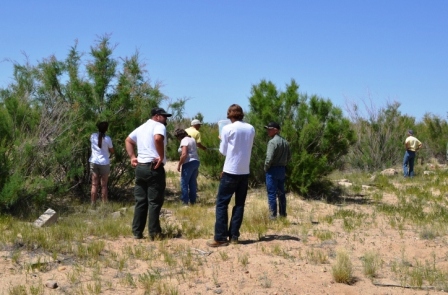
County Commissioner Ed Norden and other members of the Colorado Noxious Weed Advisory Committee tour stands of tamarisk which are targets of insect biocontrols
The Colorado Noxious Weed Advisory Committee gathered in La Junta May 29th and 30th for its quarterly meeting and annual weed tour. District 3 Fremont County Commissioner Ed Norden took part in the tour having been appointed to the state committee last fall. Committee members spent the first full day in the field viewing successful efforts to control infestations of tamarisk along Timpas Creek south of La Junta as well as in southern Crowley County. On Timpas Creek near the Comanche National Grasslands there are large stands of dead tamarisk as the result of helicopter spraying. With the tamarisk plants no longer sucking up large volumes of groundwater, there is now standing water in Timpas Creek in what had been a dry creek bed.
Dr. Scott Nissen of the Colorado State University College of Bioagricultural Sciences and Pest Management detailed the work on several research plots in Crowley County where a mixture of chemical spraying by helicopter, ground chemical control, use of tamarisk leaf beetles, and use of hydro-axes have shown great promise in controlling the spread of tamarisk.
Dan Bean of the Palisade Insectory also explained ongoing efforts to distribute tamarisk leaf beetles throughout the Arkansas Valley to control tamarisk. Bean noted that the leaf beetles have also shown good success against tamarisk in the Upper Beaver Creek drainage near Penrose and along Four Mile Creek north of Cañon City. Helicopter spraying of tamarisk has also been used effectively in Fremont County.
At the May 30th committee meeting Bean went into further detail with committee members about other research at the Palisade Insectory to utilize insects to control other invasive species of noxious weeds in Colorado.

